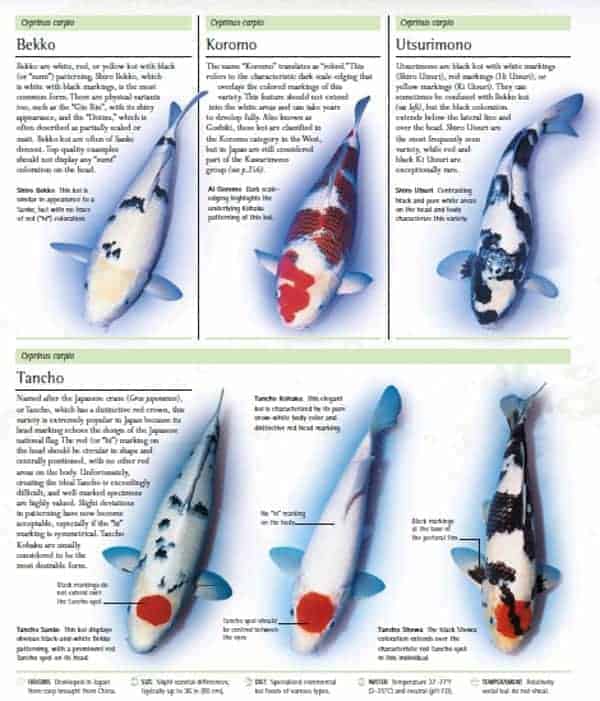Types of Koi Varieties, Classifications, and More!
kohaku koi fish

The King of Koi: The Everlasting Beauty of Kohaku
Among all the stunning koi varieties, the Kohaku reigns supreme as the undisputed king. This regal fish holds a special place in history, being the very first ornamental koi variety ever developed.
What is a Kohaku Koi?
A Kohaku koi is easily identified by its distinctive markings: a pristine white body adorned with vibrant red patterns. This elegant combination not only makes it a captivating sight, but also embodies the Japanese national flag, further deepening its cultural significance.
The Heartbeat of Nishikigoi
In the fascinating world of Nishikigoi (colored carp), there’s a well-known saying: “The journey of Nishikigoi begins with the Kohaku and ends with the Kohaku.” This proverb reflects the undeniable truth that many koi enthusiasts initially fall in love with the dazzling Kohaku, then explore other captivating varieties like the Showa or Ogon, but ultimately circle back to appreciate the timeless beauty of the Kohaku once again. This enduring appeal solidifies the Kohaku’s position as the quintessential Nishikigoi, the one that truly defines the entire class.
Exploring the Diversity of Kohaku Koi:
While the basic color scheme of Kohaku might seem simple, a closer look reveals an incredible variety within this category. There are numerous subtypes, each with its own unique pattern and characteristics. Delving deeper into these variations will unveil a whole new world of koi appreciation!
Want to learn more?
Head over to [link to information about different types of Kohaku koi] to discover the mesmerizing diversity of this iconic fish!
sanke koi (Taisho Sanshoku)
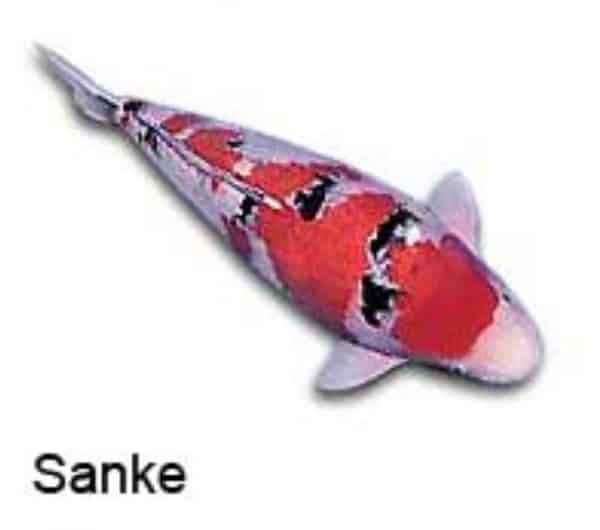
Also known as Sanke, the Taisho Sanke is a stunning tricolor koi. It has a bright white base gracefully adorned with patches of vibrant red (hi) and striking black (sumi) markings. Interestingly, these colors only appear above the fish’s lateral line, leaving the lower half a pristine white. While the fins might have delicate sumi stripes, they don’t overpower the overall balance. In contrast, Showa, another type of koi, proudly displays large areas or even wide bands of black color.
Want to learn more about the different types of Sanke koi? Click here
Showa koi fish
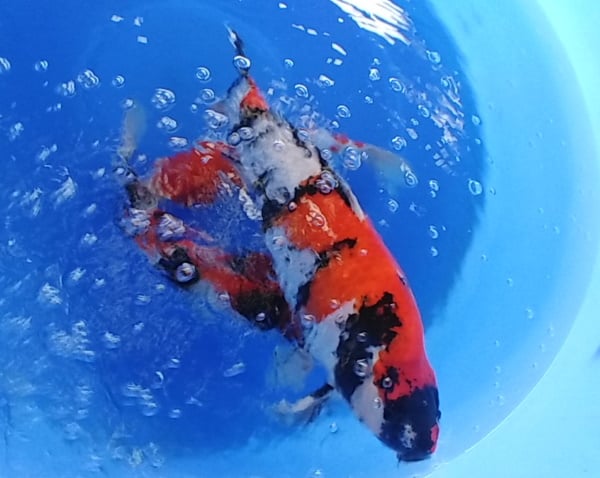
The Showa Koi: A Striking Member of the “Big Three”
The Showa, also known as the Showa Sanshoku, is a stunning variety of ornamental koi that captivates with its bold color combination. Sporting a jet-black base adorned with vibrant red and white markings, it’s easy to see why this fish holds a special place in the hearts of koi enthusiasts.
A Member of the Elite:
The Showa belongs to the prestigious gosanke, meaning “Big Three” in Japanese. This exclusive group comprises the Kohaku, the Sanke, and the Showa, recognized for their exceptional beauty and historical significance.
Origins and Development:
Jukichi Hoshino, a passionate breeder, is credited with creating the Showa in 1927. He achieved this impressive feat by crossing a Kohaku with a Shiro Utsuri variety, resulting in the striking black-bodied koi with contrasting red and white markings we know and love today.
Exploring the Showa’s Unique Features:
Beyond its captivating color scheme, the Showa boasts several distinct characteristics:
- Black body (sumi): This forms the dominant background, providing a canvas for the red and white markings to shine.
- Red markings (hi): These appear as bold, well-defined patches or patterns, adding a touch of vibrancy and fire.
- White markings (shiroji): These typically complement the red, creating a harmonious balance and enhancing the koi’s overall elegance.
Want to delve deeper into the world of Showa koi? Learn more showa koi fish
Shiro utsuri koi
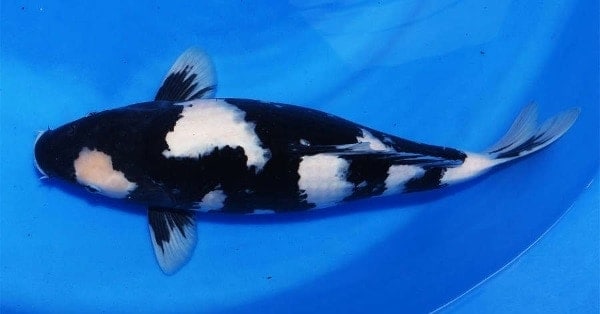
Shiro Utsuri: Beautiful Koi in Black and White
Shiro Utsuri are striking koi, adorned with bold black and white markings. Their black color appears as distinct bands wrapping around their bodies, with black on parts of the head and “motoguro” (black markings on the pectoral fins) considered desirable features.
There’s a saying in the koi world: “You start with Kohaku and end with Kohaku.” This refers to the tendency of black markings (sumi) on koi to “rise” over time, potentially affecting areas you might prefer white. This is especially true for Shiro Utsuri.
Hi Utsuri Koi
Utsuri is another very popular koi fish for Japanese koi ponds and water gardens. … A red Utsuri is called Hi Utsuri, white type is called Shiro Utsuri, and the yellow type is called Ki Utsuri. Hi Utsuri and Ki Utsuri have red and yellow markings respectively in place of the white areas on a Shiro Utsuri learn more about hi utsuri koi
ki utsuri koi
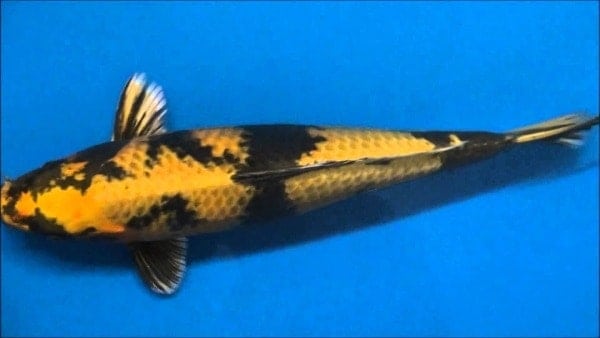
Ki Utsuri, by far the rarest type of Utsuri, combine patterns of yellow over a lacquerish black body. Ki Utsuri are judged by the same criteria as Shiro and Hi Utsuri.
Variations of Ki Utsuri include Gin Rin Ki Utsuri and Kin Ki Utsuri. learn more about ki utsuri koi
Asagi koi
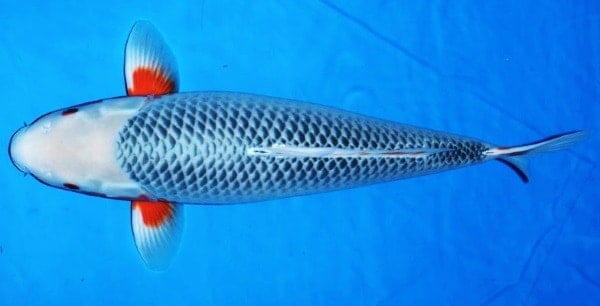
The Asagi is one of the oldest breeds of the beautiful koi. Stoic and subdued, and sometimes even considered an acquired taste, you’re sure to see this common blue-scaled koi around in a pond near you! The Asagi is one of the oldest breeds of koi. learn more about asagi koi
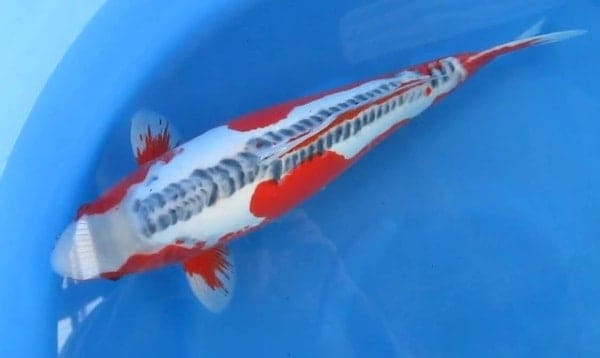
Shusui koi fish was the first Doitsu variety of koi and are one of the only two blue koi! They are a Doitsu (scale-less) version of Asagi.
The absence of scales on this koi can give off a beautiful blue color. Having Hi marks on the cheeks, head, body and fins are wonderful for this koi. learn more about Shusui koi
MATSUBA koi (maht-sue-bah)
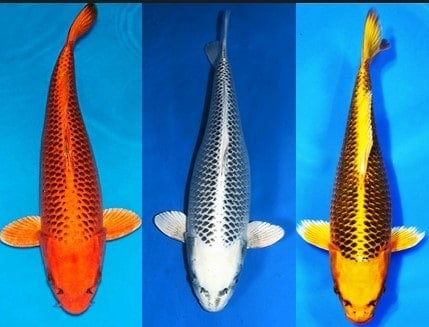
It is a one colored metallic koi with dark pigment on the scales.This variety is in the Hikari Muji class, and is considered one color regardless of the contrasting scales.KIN MATSUBA are orange-red metallic skin, GIN MATSUBA are platinum based.
learn more about matsuba koi
platinum ogon koi
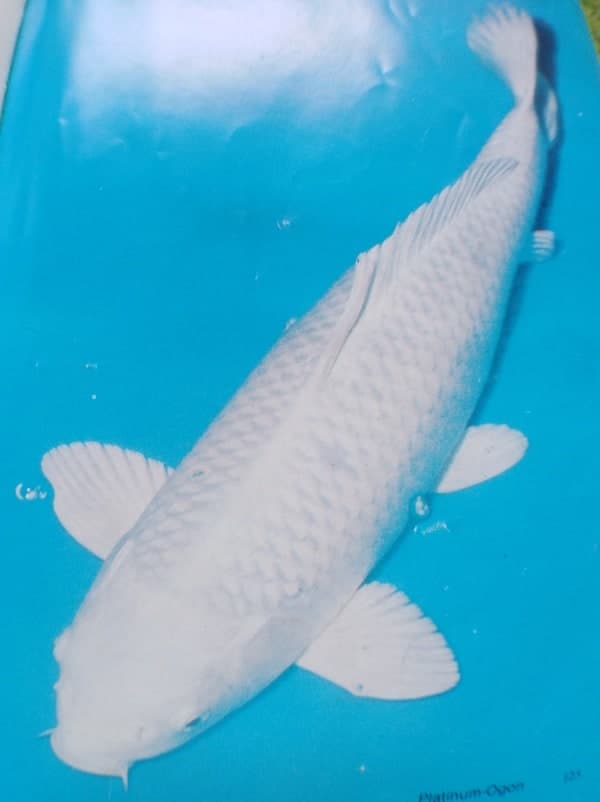
What is Ogon Koi?
Ogon (meaning “golden”) koi are metallic, solid, single-colored koi fish in the Hikarimuji class (Hikari – “shiny”; Muji – “one”).
Ogon has become synonymous with a collective name for metallic, solid-colored koi.
Having them in your pond is a good way to encourage shier koi to hand feed
A Platinum Ogon is a white single colored metallic koi. Look for clean and consistent coloration without blemishes. It is a member of the Hikari Muji class learn more about platinum ogon koi
Yamabuki Ogon
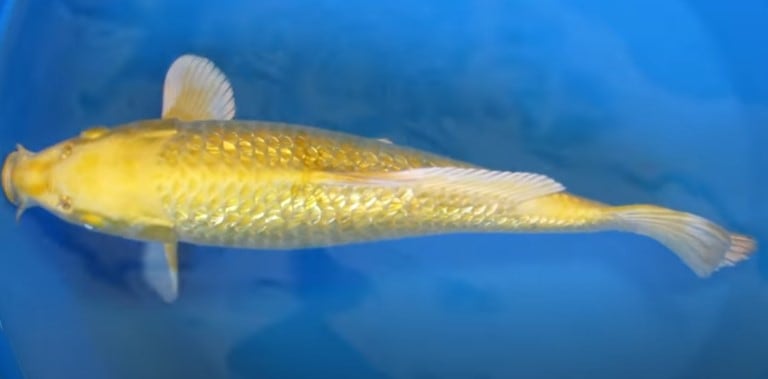
Yamabuki Ogon are koi of a solid, metallic-yellow color. As with other Ogon koi, a clean, unblemished head and body are important.
A blemished or dirty head stands out on all Ogon varieties. Yamabuki can vary in tones of yellow, from a light, vibrant yellow to a darker, more solid marigold-like color learm more about yamabuki ogon
Kujaku Koi
The Kujaku is a metallic or Ogon koi with the reticulated net-like pattern of the Asagi on its back. This is overlaid with either a gold, yellow, orange or red Kohaku-type pattern creating a striking effect. Created by crossing a Goshiki with a Hikarimuji, its full name is Kujaku Ogon, or in English, “Peacock”. learn more about Kujaku Koi
Hariwake koi
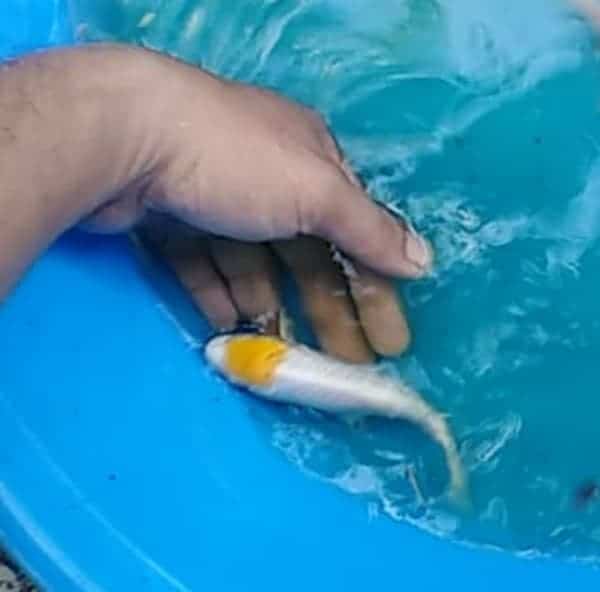
HARIWAKE (hair-ee wah-key)The Hariwake is a two colored metallic koi with a pattern. It should have a clean bright Platinum base with an interesting pattern of Hi or Beni (red-orange). When the pattern is yellow it is named Yamabuki Hariwake. This variety belongs in the Hikari Moyo class learn more about hariwake koi
kikusui koi
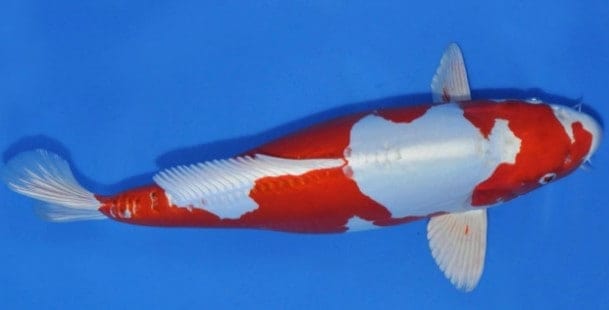
Kikusui are a scaless version of a Hariwake. Look for one with a nice Kohaku pattern that has nice sharp edges and very white skin. A Kikusui’s pattern is judged the same way as a Kohaku’s is learn more about kikusui koi
Kumonryu koi
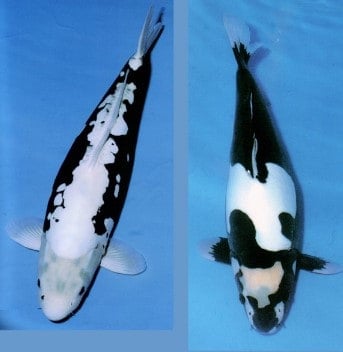
Kumonryu. The Kumonryu is a Doitsu (German) koi that has a jet black pattern that emerges like billowing black clouds against a white background. The black pattern is variable and unstable, disappearing with changes in the water temperature, reappearing sometimes as a completely different pattern. learn more about Kumonryu koi
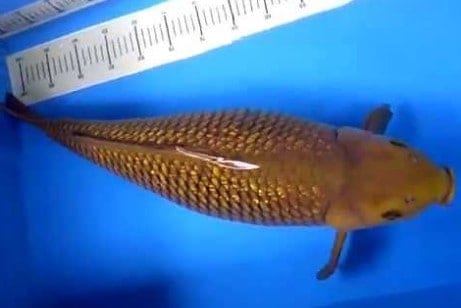
Chagoi (Chah’-goy)It is almost universally agreed to be the friendliest of the koi classifications because it is the most aggressive at feeding time and almost always the first fish to become hand-tame. … The Chagoi is basically a brown koi, however a brown koi is not necessarily a Chagoi. learn more about chagoi koi
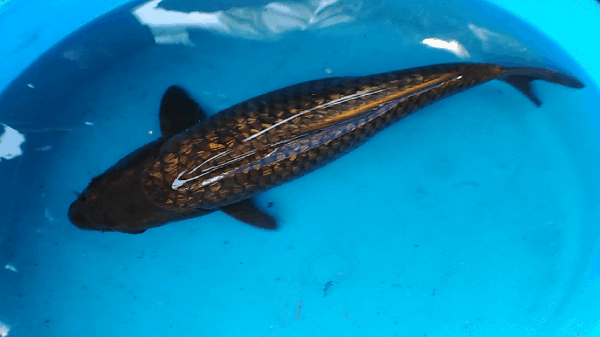
Soragoi koi Fish
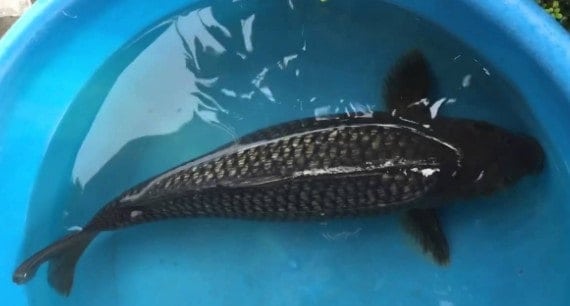
Soragoi. Soragoi, similar to Chagoi, are koi of a solid grey or silver color, combined with a subtle net pattern. Also like Chagoi, mature Soragoi are very docile and will be among the first koi in your pond to learn to hand feed. … Soragoi belong to the Ogon group of koi, which appeared in the Showa Period (1926-1989). learn more about soragoi koi
Black koi Types and their derivatives
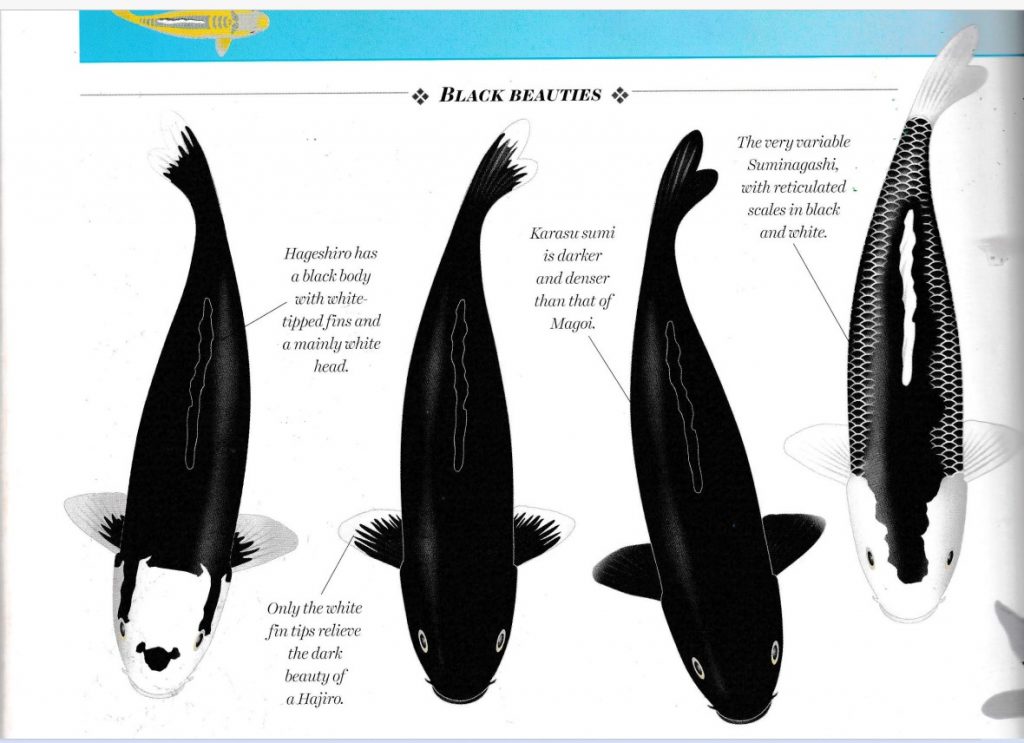
The Karasu, or “Crow,” is a very o|.d variety, with matt black fins and body and a white or orange belly. The very similar Hajiro is a btack koi with a white nose and white-tipped pectoral fins, which make it more visible in the water.
The Hageshiro adds a white head to this co[or combination, whereas the Yotsujiro’s fins are completely white. All four koi should display deep and even sumi, darker than that of the Magoi.
Suminagashi are fully scaled koi with black scales picked out in white. ln this highly variable variety, the reticulated
scales can cover all [ or part of the body.
The similar-looking Matsukawabake is an oddity, in that the distribution of black and white areas changes according to the seasons and the temperature of the water in which it is kept.
However, this does not amount to a complete reversal of the pattern. Fish can turn completely black or completely white under some
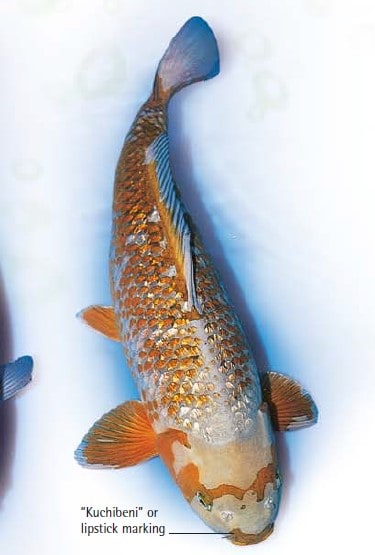
Ochiba Shigure, commonly referred to as Ochiba, combine the brown/bronze of Chagoi with the silver/grey of Soragoi. The name Ochiba Shigure translates as “autumn leaves falling on water”, a reference to the silver and bronze pattern. Variations of Ochiba include Gin Rin Ochiba and Doitsu Ochiba. learn more about Ochiba Shigure
Goromo koi
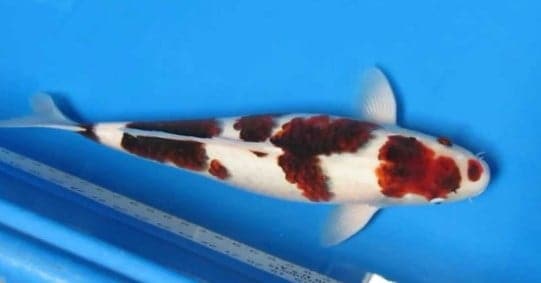
Koromo koi
Goromo Koi. This is probably the most diverse Koi variety known. Goshiki, meaning “five colored” in Japanese, are said to be five-colored Koi, although sometimes you’d be hard pressed to pick out the red, black, white, light blue, and dark blue color tones that are said to be available. learn more about Goromo koi
You might also be interested to check out on Goromo butterfly koi
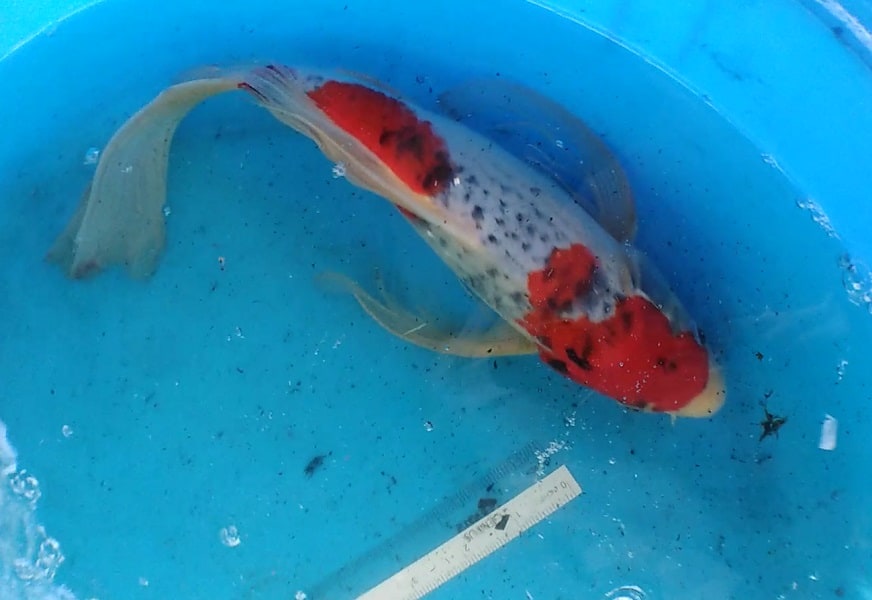
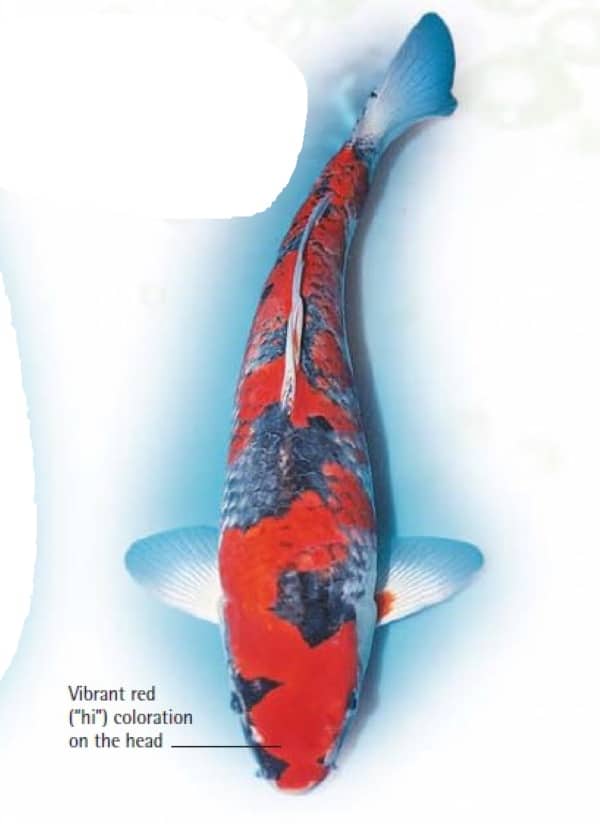
Goshiki. Goshiki was created in 1918 by breeding Asagi with Kohaku koi. translation of Goshiki is “five colors” and this koi truly shows a rainbow of colors. The black, blue, and grey colors appear in a reticulation, or a netted pattern, across the white and red and Kohaku like body learn more about goshiki koi
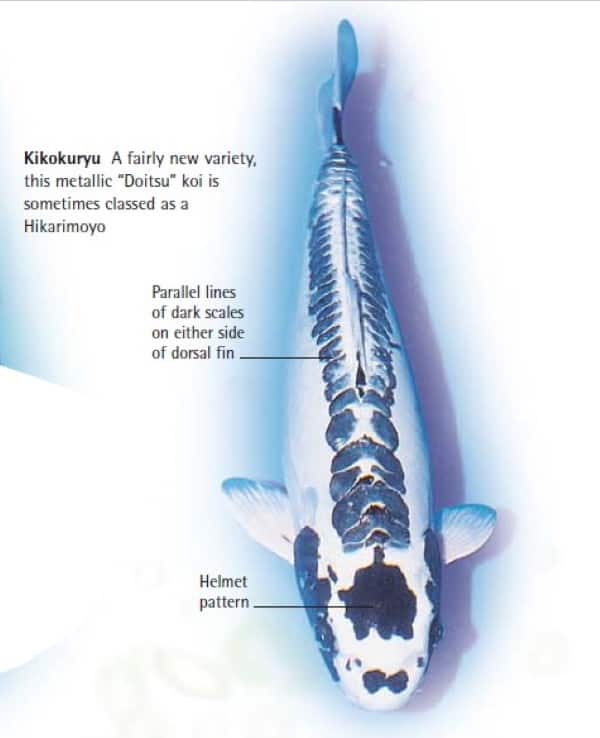
A Kikokuryu (pronounced Key-Ko-Koo-Roo)is always a metallic and always a doitsu (scaless or partially scaled) variety of Koi or Butterfly Koi. Metallic refers to skin, color, and pec fins having a lustrous sheen to them. learn more about kikokuryu koi
Tancho Koi
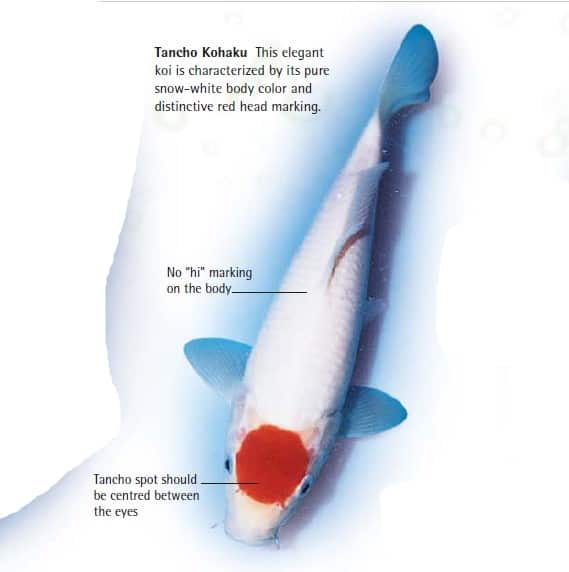
Tancho are koi that have a single hi marking isolated on the head, and bodies de-void of hi markings completely. Tancho most generally refers to the Kohaku that sports a lone circular pattern of hi on the head and a solid white body. learn more about tancho koi
Kawarimono koi
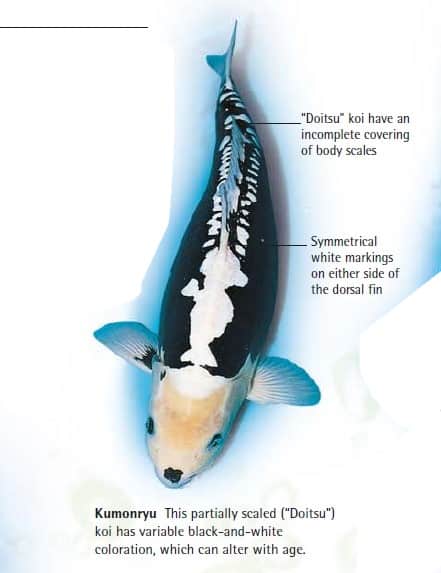
is a broad classification used for a wide variety of non metallic Koi that don’t fit into other classes. Some examples are breeds of their own learn more about Kawarimono koi
Ghost Koi Fish
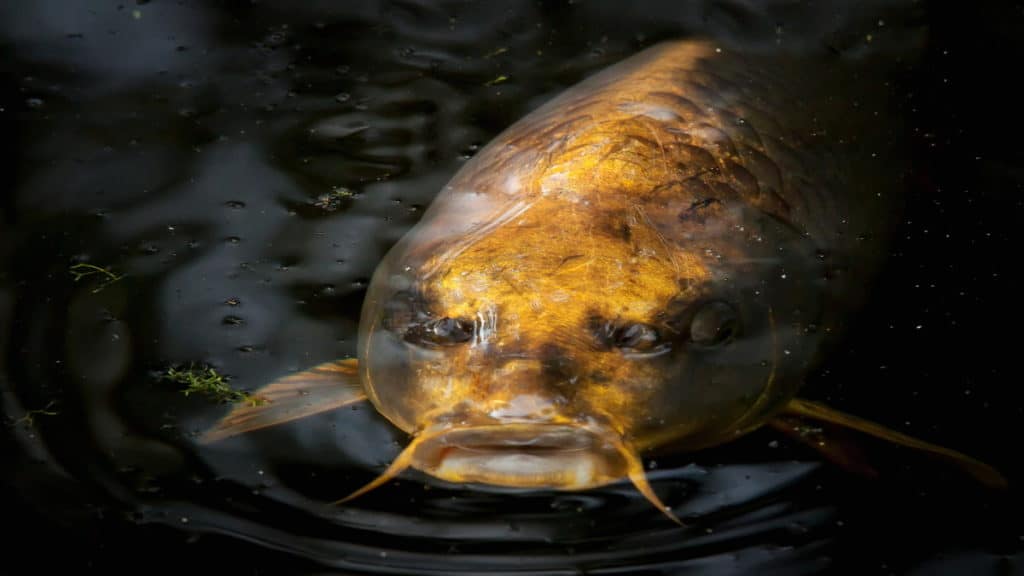
The offspring from a cross of a metallic Koi and a wild, dark-colored carp are known as Ghost Koi. Notably, the most striking areas of a Ghost Koi are the metallic head and flashy pectoral fins that glimmer in the sunlight and disappear into the depths of a dark pond like a ghost, hence the name. learn more about ghost koi
- Kohaku
- Taisho Sanke
- Showa Sanshoku
- Tancho koi
- Shiro Utsuri
- Hi Utsuri
- Ki Utsuri
- Asagi koi
- Shusui koi
- Matsuba
- Platinum Ogon
- Yamabuki Ogon
- Kujaku koi
- Hariwake koi
- Kikusui koi
- Kumonryu Koi
- Beni Kumonryu
- Chagoi koi
- Soragoi koi
- Ochiba Shigure
- Goromo koi
- Goshiki koi
- Kikokuryu koi
- Kin Kikokuryu
- Kin-Ki-Utsuri
- Kin-Showa
- Ginshiro
There are fourteen different varieties of Koi, with a fifteenth variety that is used as a sort of a catchall variety for all of the different types of koi that do not quite fit into one of the other fourteen slots.
This last variety is known as the Kawarimono, and a large percentage of Koi are placed in this category.
Inclusion in this variety has no bearing on the quality of the Koi.
Placement in the fifteenth variety simply means that there is something not quite right about the fish.
It may be attractive and healthy, but it does not fit the “breed standard” for any of the individual varieties.
All Koi have a unique beauty, but those who are entered in shows must resemble this standard.
Crossbreeding For Different Varieties
The many different color varieties that you will see were brought to fruition by crossbreeding fish that are closely related to each other.
Crossbreeding tends to make a genetic line more stable, bringing out the good qualities while pushing back the bad.
Those who are preparing to be Koi breeders are advised to learn about the different types of koi varieties so that they will know which ones they are interested in breeding and raising.
Asagi

The Asagi Koi is one of the initial varieties of Koi. The body of the Asagi is a blue color, with the lighter shades of blue most preferred.
The scales on the skin of the Asagi are given high importance. The edges of these scales must all be equal in length, and must be on the entire body of the koi from its tail to its head.
The red (Hi) color that appears on the sides of the Asagi, on the head, and on the fins sometimes looks more orange than red.
The Hi needs to be symmetrical on both sides of the Koi’s cheeks all the way to its eyes.
Utsurimono Black Beauties: The unique traits and varieties of Utsurimono The Complete Guide 2021
Three varieties of the Utsurimono have been painstakingly developed. These are the –
Ki Utsuri, which is a yellow and black Koi

Hi Utsuri, a red and black Koi
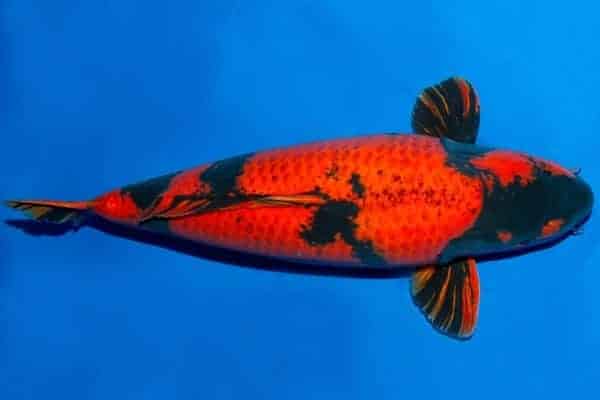
Shiro Utsuri Shiro, a white and black koi

For that 1960s llok, this “designer” Doitsu Shiro Utsuri is hard to beat. More sumi may yet emerge, as the shoulder patch is not as clear-cut as it might be. The body could do with more volume, but that will come. Pectoral sumi is beautifully balanced.
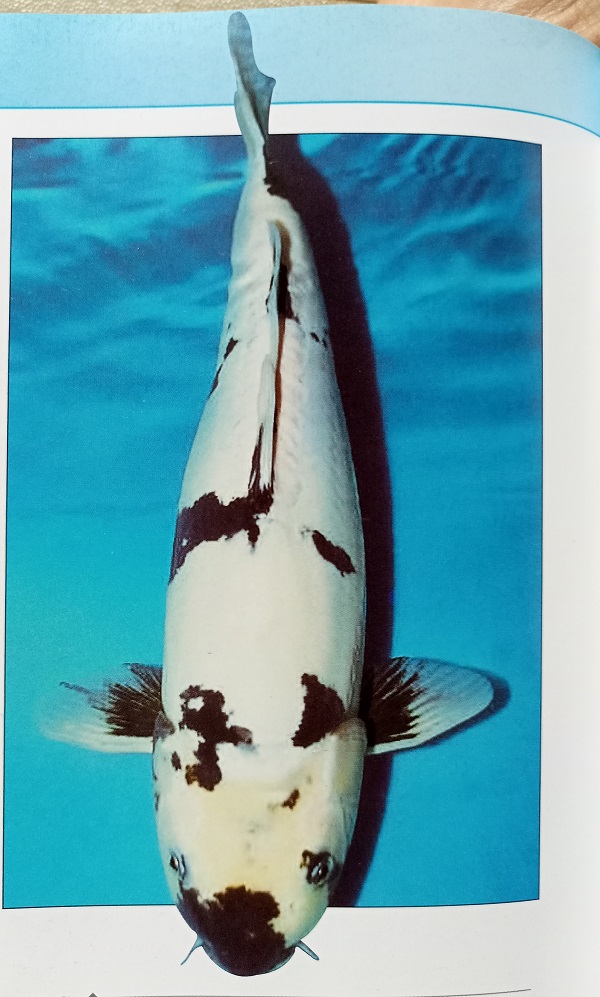
The Utsurimono should be heavily marked with black (Sumi) in order to display a prominent contrast with the yellow, red, or white.
All colored need to be somewhat balanced, as this helps to call attention to the pattern on the Koi.
The Utsurimono is sometimes mistaken for the Bekko koi. There are two differences to look for that will allow the observer to tell the two varieties of Koi apart.
The main variation is that the Utsurimono is a black Koi with red, white, or yellow markings, while the Bekko Koi are either white, yellow, or red Koi that have black markings.
The Utsurimono also feature black markings on their heads that run all the way down to their noses. The Bekko Koi do not have black markings in this area.
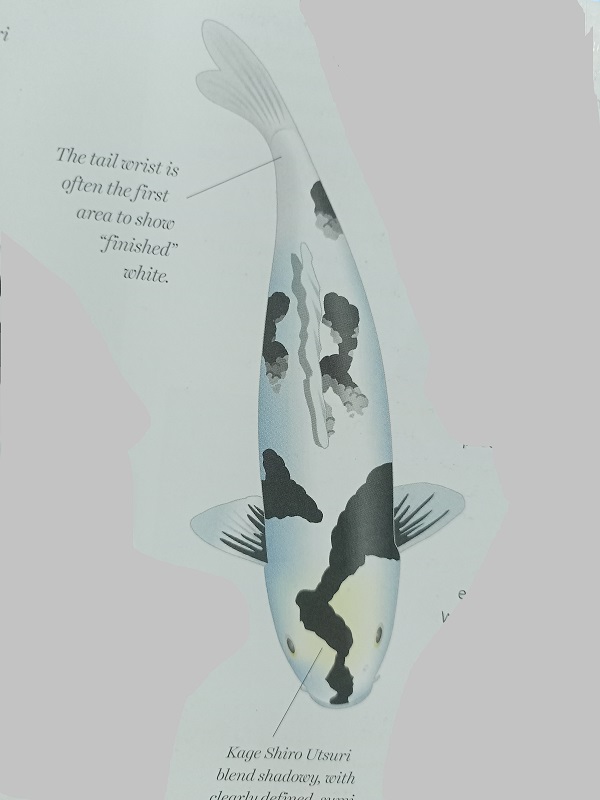
The tail wrist is often the first area to show “finishe”white
Shiro Utsuri Head Patterns
Below are different Shiro Utsuri head patterns that make them more beautiful If you happen to have these beautiful markings in your Shiro utsuri koi fish you will have more additional points in the koi show
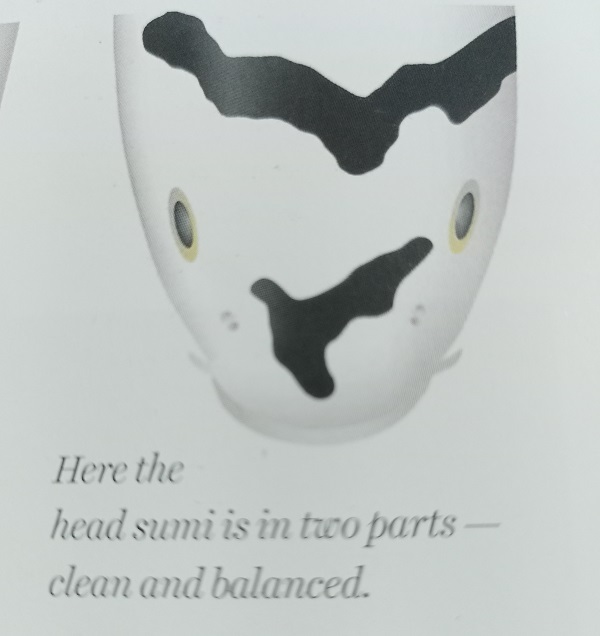
Here the head sumi is in two parts clean and balanced.
This interesting, but rather heavy and fussy head sumi in Shiro utsuri may fuse together later.
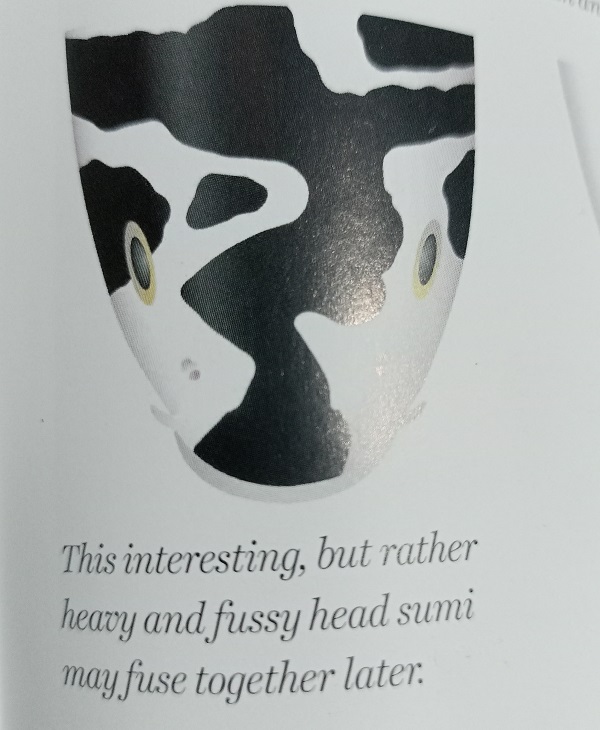
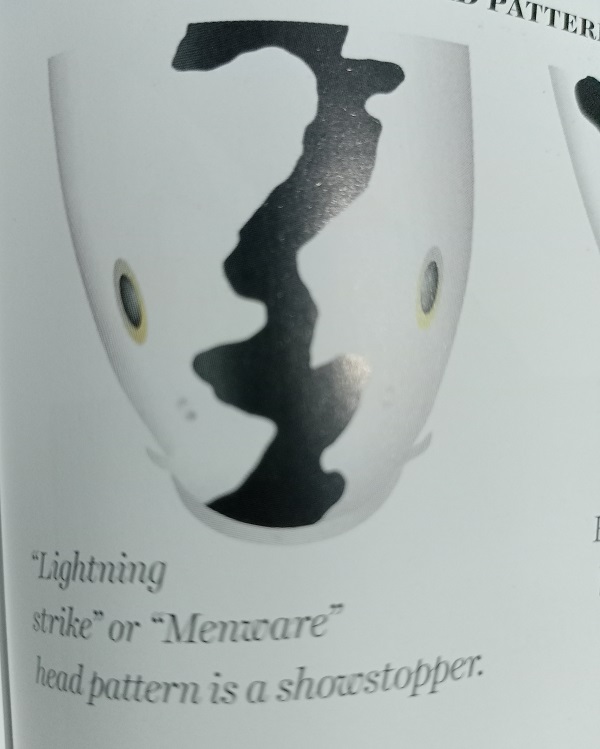
Lightning strike or menware head pattern of shiro utsuri is a showstopper
In modern-style Shiro Utsuri, the head sumi is uncluttered to show off the white skin.
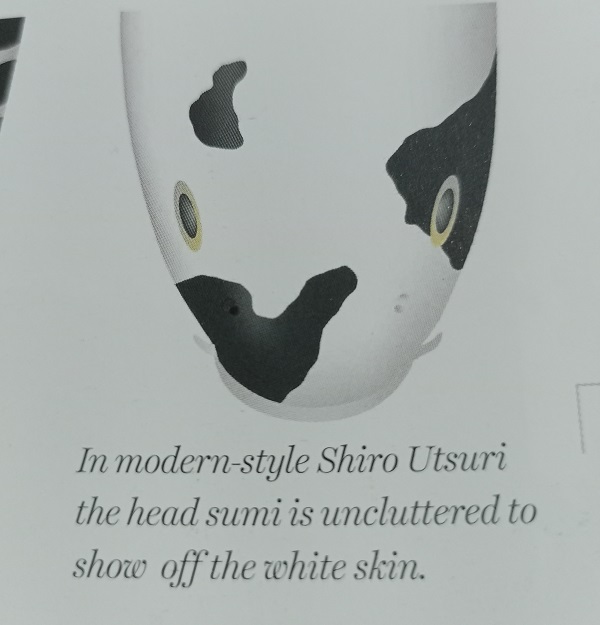
If you want to learn more about Koi fish care check out Koi: A Complete Guide to their Care and Color Varieties
Characteristics to look on Shiro Utsuri Pectoral Fins
Motoguro may take the form of a solid patch of sumi at the pectoral fin ball join or a radiating style, as here Both are quite distinct from Sanke

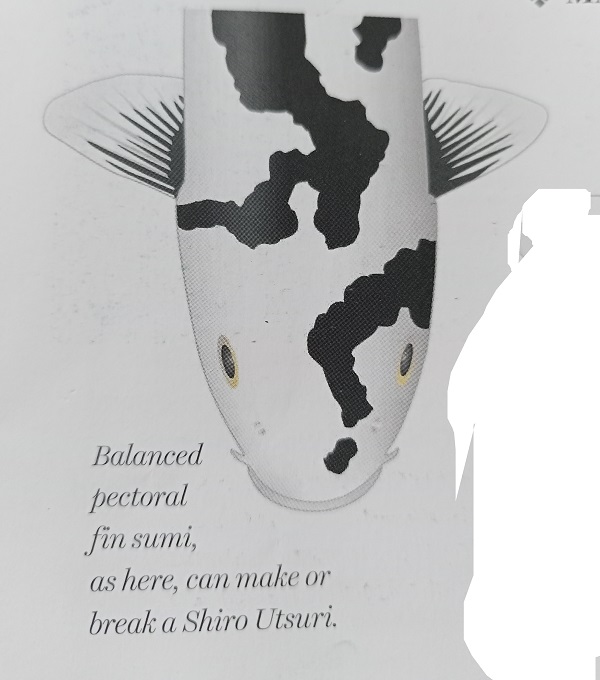
Balance pectoral fin sumi, as here, can make or break a Shiro Utsuri.
Either fin pattern is acceptable, but together in th same fish they do not work
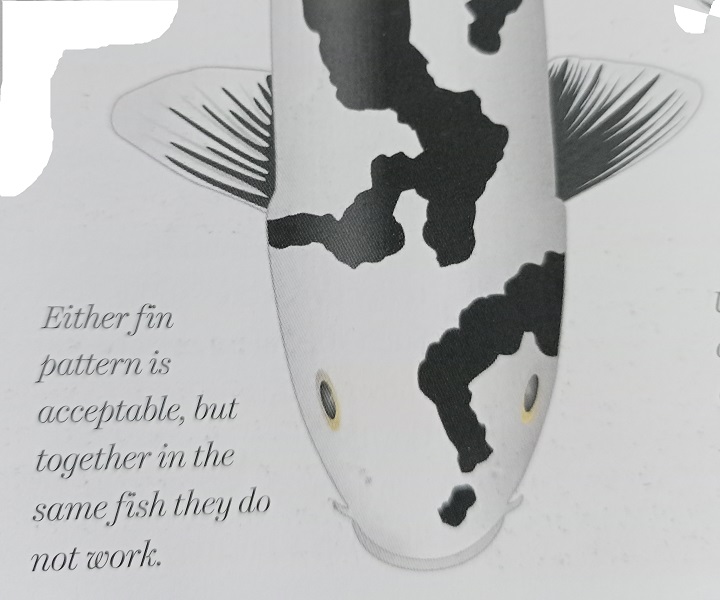
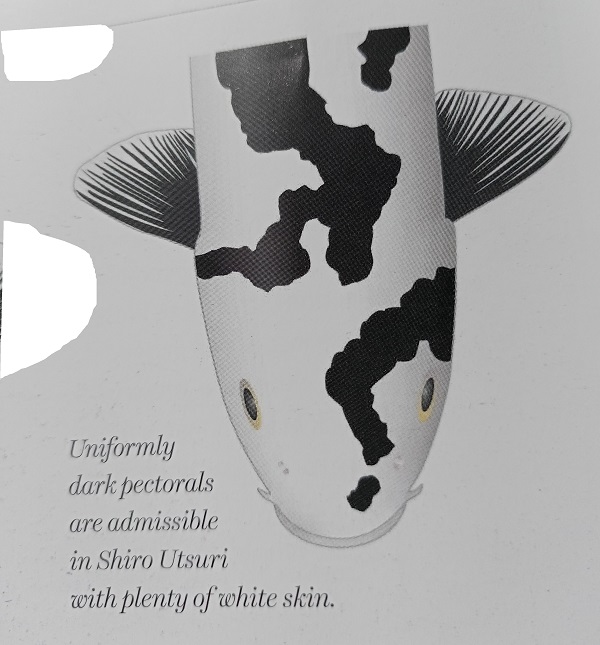
Uniformly dark pectorals are admissible in Shiro Utsuri with plenty of white skin
Bekko
The Bekko variety is a white, yellow or red Koi that can be identified by the unique black markings.
This assortment has small and very simple black markings that are not included on the head of the Koi.
The Shiro Bekko is white with black markings. The Aka Bekko is red with black markings The Ki Bekko is yellow with black markings, and is considered to be rare.
Shusui koi

The Shusui is the result of a crossbreeding that took place in 1910. One Yoshigoro Akiyama crossed an Asagi Koi with a Doitsu Mirror carp.
He ended up with a fish he called the Shusui. The color of this Koi is comparable to that of the Asagi.
The Shusui has a head that is a bluish gray color, with red on the jaws of the Koi.
The skin is a lovely sky blue, with darker fish scales outlining the lateral and dorsal lines.
Lines of red run down the back from the gills to the tail. There are several types of Shusui, including –
Hi Shusui Hana Shusui Ki Shusui Pearl Shusui
Koromo
The Koromo koi is a relatively new type of Koi that appeared around 1950.
The Koromo came into existence by crossing the Kohaku with the Naruni Asagi.
The Koromo has a lovely pattern of deep red edged with black on a white background/body.
The red is described as being in a lace pattern, and the markings of the Koromo are prone to variations, depending on which variety you are looking at.
The most commonly seen varieties include –
Budo Sanke Koromo Sanke Koromo Showa Budo Goromo

Budo Goromo are a Goromo with shading that completely covers the Hi, creating a purple color. Budo means grape in Japanese.
Look for a Budo Goromo with a Kohaku pattern on it’s back. What makes an Budo Goromo? Goromos were created by accident.
How? A breeder was breeding Goshikis and a goshiki with a white background and a net pattern on the Hi appeared. This Koi was carefully bred and now we have the Goromo variety. Ai-Goromo Sumi-Goromo
Goshiki
In Japan, the word “goshiki” means five colors, which are red, white, black, dark blue and blue.
All of these colors can be mixed on the body of one fish. The result of this is a Koi that has a rather purplish tint.
Originally created by crossing the Asgai Koi with the Sanke Koi, the Goshiki has patterns that are quite striking.
These surprisingly lovely fish are very popular with those who keep Koi as a hobby.
Kawarimono
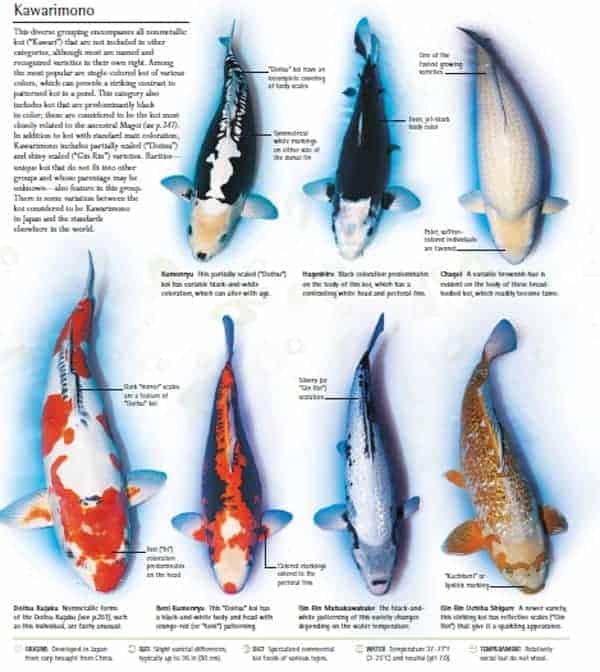
The Kawarimono classification is given to many non-metallic fish who do not seem to fit in any other variety of Koi.
This classification should in no way be considered as a variety in which to dump the oddly marked Koi! Many gorgeous crossbred Koi come from the Kawarimono variety.
Often, these are not bred on purpose, but appear in a spawning as a “sport” koi.
Generally, the Kawarimono are divided into three groups –
Single-colored Koi Black Koi Other colors of Koi Ochiba Shigure
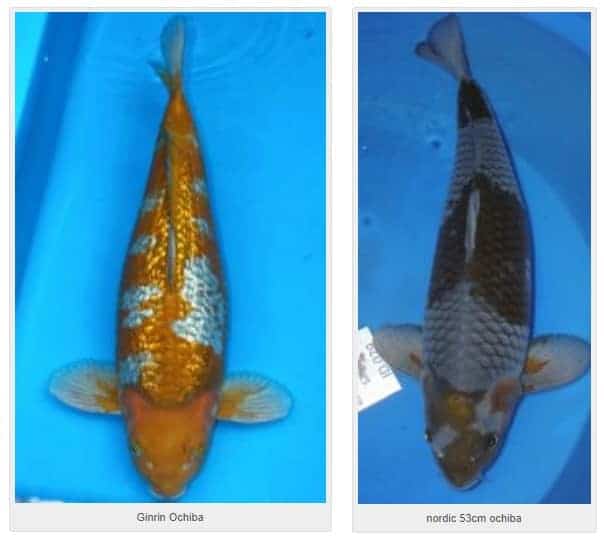
Have you ever seen a soft gray colored koi with gold patterning? If you have, you likely would not forget, because it is very different looking than the brightly colored koi we are used to seeing.
This quietly refined and elegant koi is called an Ochiba Shigure, which aptly translates to “autumn leaves on water”. The delicately reticulated scales do indeed give an impression of leaves floating on a calm pond, with the golden-leaved trees reflected on the surface.
A relative newcomer on the koi scene, having been around only since about the mid-90s, the Ochiba is actually a cross between a gray Soragoi and a golden brown chagoi.
These two ancestors have a reputation of being the friendliest of koi, and the Ochiba has happily inherited that trait.
Many hobbyists will have one of these types koi in their collection for the purpose of encouraging other, shyer koi to “come out of their shells” and be more sociable.
They will be the first to come up to greet you as you approach your pond, and will readily eat from your hand. learn more here kumonryu koi

Kumonryu. The Kumonryu is a Doitsu (German) koi that has a jet black pattern that emerges like billowing black clouds against a white background. beni kumonryu koi
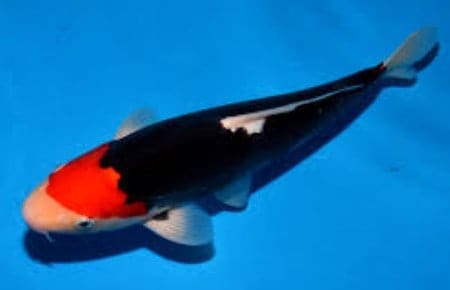
Beni Kumonryu came from Kumonryu and Doitsu Kohaku. Since Doitsu varieties have no scales, their colors can be very bright and bold.
Beni Kumonryu are a rare form of Kumonryu, they have red along with the black and white. They are scaless and their pattern actually changes throughout the year.
No one is absolutely sure what causes the color change, but the two best theories are a change in temperature or a change in pH. Beni Kumonryu are usually black in the winter.
The white and red usually appears in the spring and summer. Chagoi koi

Helmy Iskandar
The Chagoi is known as the “gentle giant”. They are not the most colorful or fanciest of Koi varieties, but make of for that in other fabulous ways! Chagoi are the friendliest and most docile Koi breed to the point that most actually like interaction with people. In as such they tend to make all of your other fish more friendly and trusting. They are also known to grow large and grow quickly. They come in various shades from brown, reddish brown, beige,copper/rootbeer, and even shades of green. learn more about chagoi at hanoverkoifarms.com Soragoi Koi

Tuấn Huỳnh Ngọc
Soragoi, similar to Chagoi, are koi of a solid grey or silver color, combined with a subtle net pattern. Also like Chagoi, mature Soragoi are very docile and will be among the first koi in your pond to learn to hand feed. … Soragoi belong to the Ogon group of koi, which appeared in the Showa Period (1926-1989).
Ochiba-Shigure
Ochiba-Shigure is an interesting name for a Koi. The words translate to mean “dead leaves on the water”.
These fish are clothed in the basic colors of gray and green with a network of brown lines, rather like the stems of a dead leaf.
What is a Karashigoi koi?
From readying a few of my books in brief a kigoi is a solid yellow koi,sometimes with a white belly. A Karashigoi is a cross between a kigoi and chagoi which creates a more yellow form of a chagoi.
Hikarimono (Ogon)
The word “Hikari” translates from the Japanese to mean “metallic”.
“Mono” means one particular single color. This means that the ogon koi is classified as a highly metallic-colored variety of Koi. There are –
Metallic silver, or Platinum ogon koi,
Platinun- Ogons are metallic white and are one of the most popular Ogons.
The color should be as white as fresh mountain snow. As with other Ogons
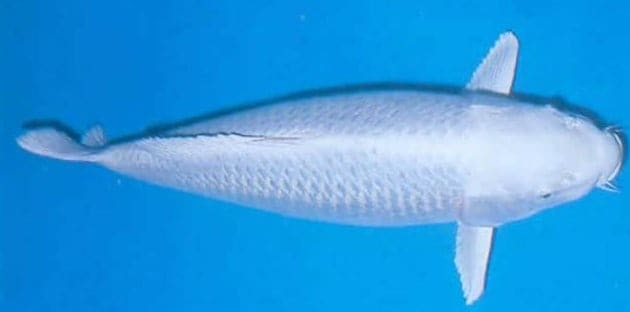
Metallic yellow, or Yamabuki ogon koi.
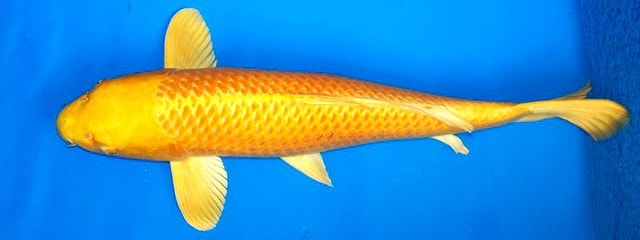
These two colors are the most common, and the easiest shades of ogon koi to purchase.
There is also the –
Fuji ogon koi, where only the head of the Koi is metallic Orenji ogon koi, which is all orange like a common goldfish, with a red splotch on its back. Goldfish lovers are usually quite fond og the Orenji.
Except for the Fuji, the metallic color of the ogon koi must be the same from the head to the tail, and even flow down to the ends of each fin to be considered “correct”.
The size of the fins also matters a great deal. Everyone wants to see long fins on the ogon koi, as they help to counterbalance the plain Koi body.
Ogon koi are a single solid colour with a metallic appearance. This variety is very popular, particularly with those new to keeping koi.
These fish can be a variety of attractive colours. Cream specimens are rare and the most popular choices are bright yellow (Yamabuki ogon koi) and Platinum (Purachina ogon koi).
learn more about ogon koi fish
Hikarimoyo-mono
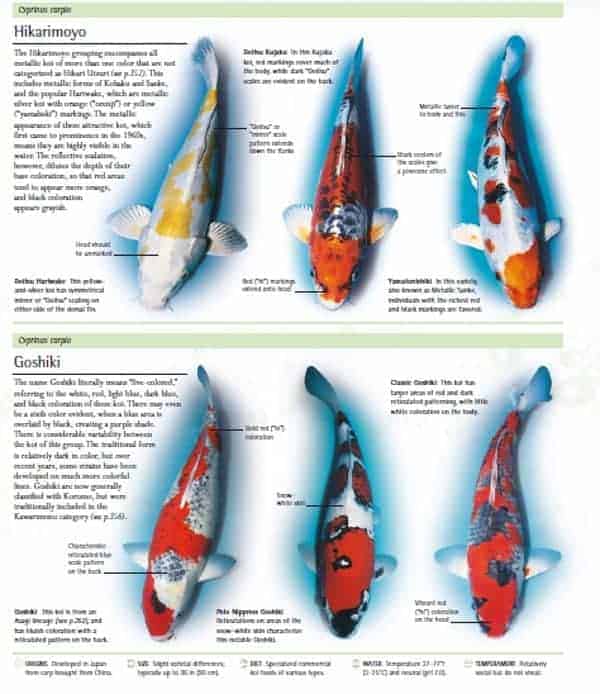
Any Koi that are metallic and have several colors, but do not come from Utsuri lineage are in this group.
The Hikarimoyo-mono was created by crossing a Platinum Ogon with several other varieties, none of which had any Utsuri genes at all. This cross resulted in the
- Gin Bekko
- Kujaku koi

The Kujaku is a metallic or Ogon koi with the reticulated net-like pattern of the Asagi on its back. …
The development of high quality Kujaku has led to their being judged in a category of their own at recent koi shows.
Kujaku are koi with a solid white base, accented by a black net pattern along with patterns of red/orange/yellow.
The net pattern is created by a black edging on each individual scale.
Variations of Kujaku include Doitsu Kujaku, Tancho Kujaku and Maruten Kujaku.
There is another group in this classification, which has fish of two colors, either gold, orange, or platinum.
These Koi are called Hariwake. The Orenji Hariwake and the Hariwake matsuba koi are two examples of this variety. Hariwake koi
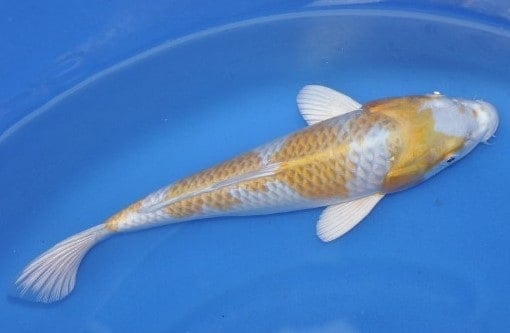

The matsuba koi is basically an Ogon with reticulation. It is a one colored metallic koi with dark pigment on the scales.
This variety is in the Hikari Muji class, and is considered one color regardless of the contrasting scales.
KIN matsuba koi are orange-red metallic skin, GIN matsuba koi are platinum based. kikusui koi

Kikusui – Kikusui. Although technically they are the Doitsu version of Hariwake, scaleless white koi with patterns of orange or yellow
goshiki koi
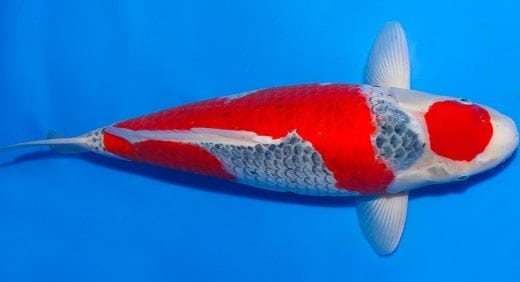
goshiki koi pronounced (gosh-key or Go-she-key by some) are an interesting breed of Koi. The name means ‘five colors” in Japanese, but frankly it is not a fitting name in my opinion with today’s goshiki koi. You do not readily see five colors at a glance and it is a stretch to do so no matter. This is one breed I feel the Japanese creators misnamed.
Most times the Japanese names are right on the money as for descriptive names that tell a story of what the Koi breed looks like.
The name was probably created because of the look of some of the first goshiki koi created when they crossed a Sanke to and Asagi. Today yet I don’t see the “:five colors) easily. Anyway, enough about that.
The goshiki koi basically a white based Koi that has a fishnet black pattern on top of the white base that covers the entire back and runs from the top of the back down to the lateral line (center line of the side of the fish that runs from gill plate to tail base).
On top of the fishnet pattern there is a red or orange pattern like the Kohaku.
This pattern is called the Hi (hee) plate. One difference in this Hi plate from Goshiki to Kohaku is that the Goshiki Hi tends to be much thicker, bolder and more neon in color intensity as compared to the Kohaku Hi plate which can be a glossy red/orange but not neon.
The Goshiki Hi plate actually glows and gives the impression of thickness to the point that the Hi plate can look like a sticker stuck on top of the fishes fishnet pattern.
There are also offshoot breeds from Goshiki called Goshiki Sanke and Goshiki Showa. We won’t get into those details now though.
The term peacock koi refers to the five colors on the body of the koi.
The base color of this variety is white and the fins are generally white and free of any pigment.
The pattern markings on Goshiki are red, or Hi. … Kloubec Koi Farm is a breeder of Japanese Goshiki variety koi. Good read from http://nishikigoi.life article written by Author Mark Gardner Goshiki, a five coloured fish, created in the early 1900s have developed tremendously in recent years to the point where some consider them the 4th Gosanke, in place of Shiro Utsuri.
In this article we’ll look at the history of the variety, some of the most prominent breeders and the huge array of different styles that exist.
HISTORY According to Dr. Takeo Kuroki’s book ‘Modern Nishikigoi’ Goshiki were produced by crossing Asagi with Aka Sanke or Aka Bekko in 1918.
According to Shuji Fujita’s ‘Nishikigoi Mondo’ a primitive Goshiki existed from the mutation of Narumi Asagi and were known as Goshiki Asagi. Masayuki Amano’s 1968 ‘General Survey of Fancy Carp’ gives almost no mention to Goshiki, indeed the only references appear in reproductions of Masamoto Kataoka’s gene trees.
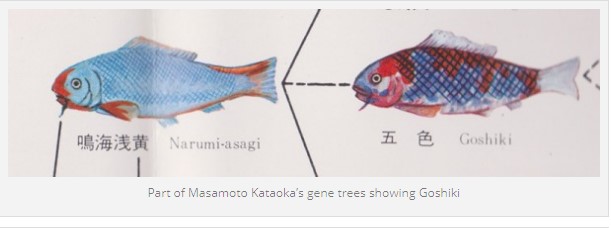
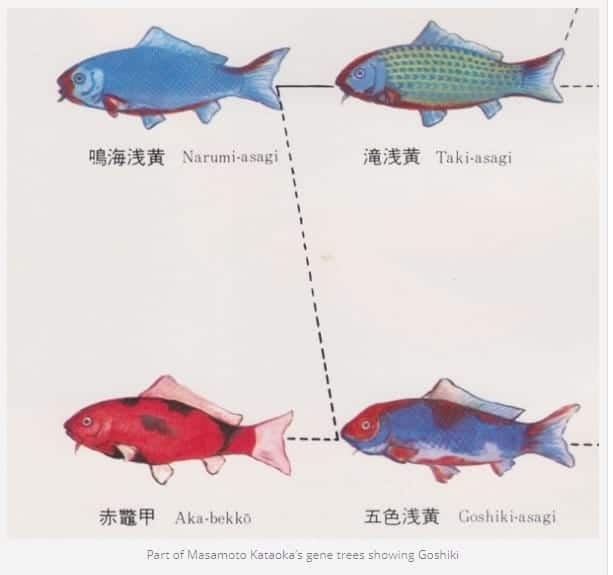
The first shows Goshiki Asagi being produced from Narumi Asagi and Aka Bekko, to then be bred with Kohaku to produce Koromo. The other shows Goshiki coming from Narumi Asagi. learn more
Kohaku
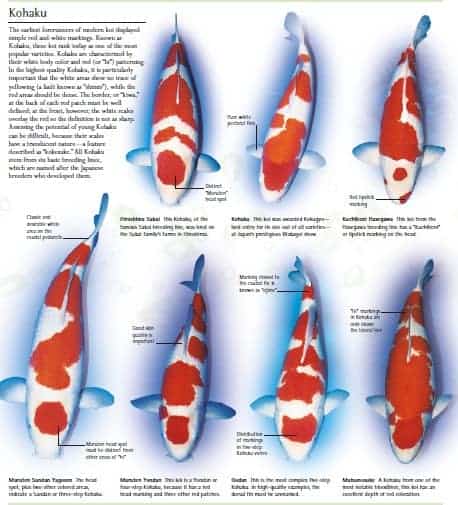
The Kohaku is a White koi with red, or Hi markings. The color white should look as if it is freshly fallen snow,
and there should be no superfluous marks on the white to distract the eye from the pristine color.
The clarity between the Hi color and the white is called the Kiwa.
The pattern on the Kohaku should have depth and should be as well balanced as possible.
There are several different pattern types, including the –
- Inazuma, which means lightning strike in Japanese.
- Nidan is the name for two red or Hi markings on the white background of the fish.
- Sandan is the name for three red or Hi markings on the white fish.
- Yondan is the name for four red or Hi markings on the Kohaku.
- learn more about kohaku koi click here https://www.giobelkoicenter.com/kohaku-koi/
Taisho Sanke
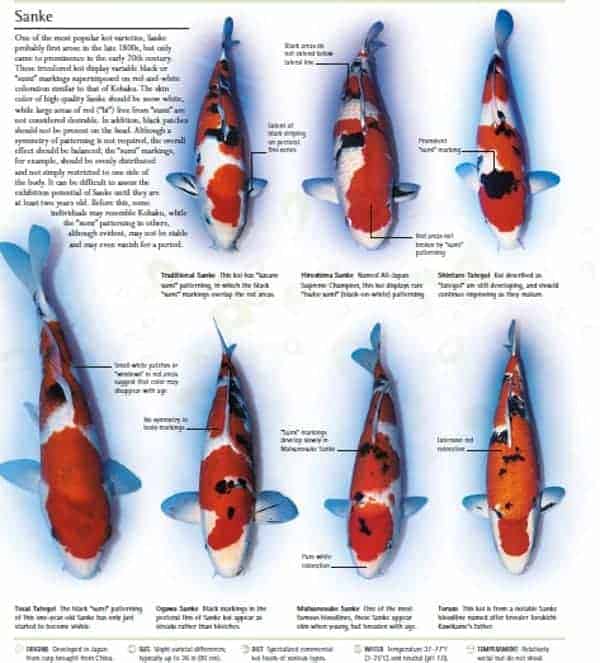
The Taisho Sanke is a Koi carp with three different colors. In this instance, the colors are red, or Hi, black, or Sumi, and white.
The color depth and the balance of the pattern on the fish is important, just as it is on the Kohaku.
The Taisho Sanke should not have any black (sumi) on the head.
Black (Sumi) is welcome on the fins, and most particularly on the pectoral and the caudal fins. T
his is taken as a sign that the Sumi color should stay even over the entire body of the fish.
The red (Hi) patterns may be on just a part of the body, or can extend back over the entire length of the body.
Showa Sanshoku
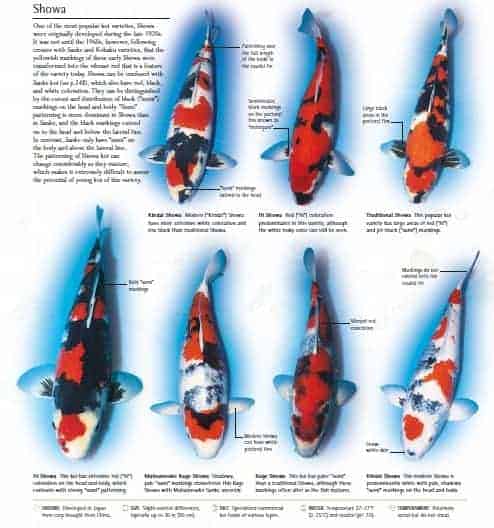
The Showa Sanshoku Koi has much more black (Sumi) included in its patterns than does the Taisho Sanke.
In fact, this classification is mostly black with a foreground of red and white markings.
Color depth is very important in this variety. The black (Sumi)should be deep and dark, the color of an object made of the dense and dark black wood known as ebony.
The red (Hi) markings need to be a blood red color, and the white should be as crisp and clean in appearance as a freshly washed and starched white shirt.
The white color on the Showa Sanshoku should be even and uniform on the base of the pectoral fins.
There are several different varieties of the Showa Sanshoku that can pop up in other Koi classifications, such as the –
Koromo Kawarimono (Kage Showa, Kankoko Showa) Hikari-Utsurimono (Kin Showa) Tancho Showa
What is a Chagoi koi?
Chagoi Koi – Mr. Personality (Chah’-goy) … You’ll discover this pet is probably more intelligent than other koi in your pond too.
It is almost universally agreed to be the friendliest of the koi classifications because it is the most aggressive at feeding time and almost always the first fish to become hand-tame
The Cha-goi is a part of the catchall class known as Kawarimono. “Cha” is the word for a tea-colored Koi that is a very fast grower.
The Cha-goi is very easy to tame, and most people thoroughly enjoy having this variety in their pond.
How many types of koi are there?
Types of Koi Varieties. There are over a 100 different types of koi (Nishikigoi).
To find the proper koi classification you will need to look at their colors, patterns, and body confirmation.
Each type of koi fish variety has it’s own specific details for identification and can described based off another classification of Japanese Koi type.
For example, a Showa Sanke is a koi with calligraphic Sumi pattern on Kohaku and the Goshiki created by breeding Asagi with Kohaku. View popular koi varieties below and click to learn about each type of koi.
What type of fish is a butterfly koi?
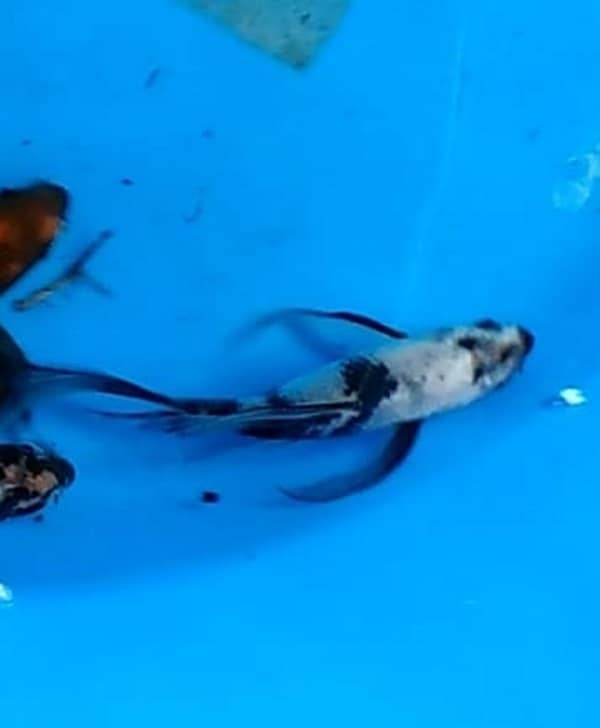
Butterfly koi, longfin koi, or dragon carp are a type of ornamental fish notable for their elongated finnage.
The fish are a breed of the common carp, Cyprinus carpio, which includes many wild carp races as well as domesticated koi (“Nishikigoi”). … They are also sometimes referred to as Dragon Koi.
Onagaoi
Also known as American koi, Butterfly koi, Longfin koi, and Dragon koi, the Onagaoi has beautiful long fins reminiscent of a butterfly’s wings.
The Japanese bred these koi, hoping to improve the hardiness of all koi by doing so.
A type of wild fish called Indonesian Longfin river carp were captured by these breeders to use in breeding experiments.
These carp were bred with koi that were more traditional in appearance.
The fish that resulted from this breeding had the long fins and the resiliency that hoped for.
Koi Purists Dislike the Butterfly
Other breeding experiments carried out in the hopes of setting the different patterns of traditional koi onto the long finned.
This attempt at crossbreeding was mostly successful. Many koi purists are adamantly against the Onagaoi.
This is the reason why many of the people who sell koi do not offer this variety.
Famous breeders in Japan would not think of breeding the Onagaoi.
These koi are not popular anywhere in the world except for the United States.
Learn more about butterfly koi
What is a ghost koi?
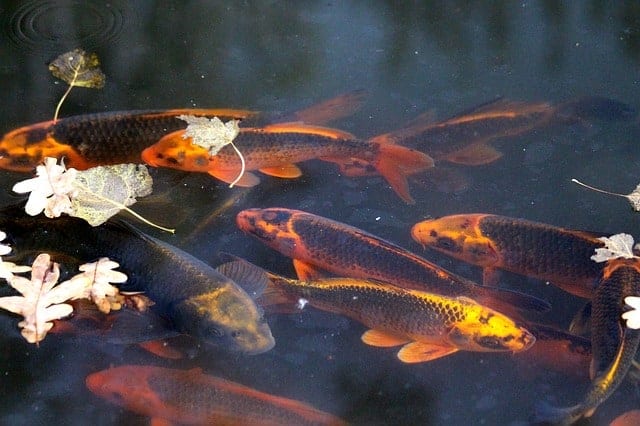
Ghost Koi.The Ghost Koi that surfaced in the early ’80s are a hybrid mix of wild carp and single-colored metallic Ogon koi.
They are also referred to as Ghost Carp—one of the reasons that koi purists don’t recognize them as true Nishikigoi at all.
Tancho koi
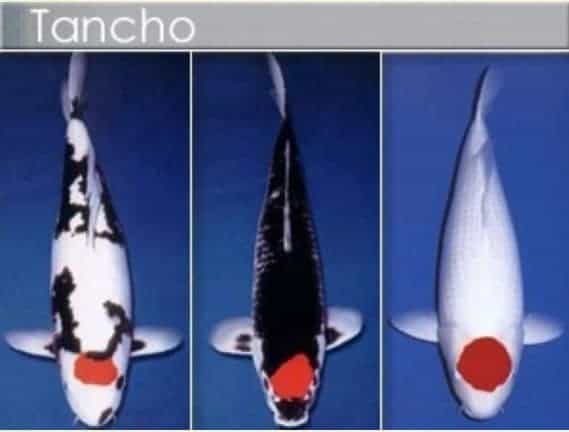
Koi with a red head patch are called “Tancho.” Most common are “Tancho Kohaku (all-white Koi with Tancho),”
“Tancho Sanshoku (white Koi with Sumi similar to Shiro Bekko, and with Tancho),” and
“Tancho Showa (Showa Sanshoku without red markings except for Tancho),” etc. However, “Tancho Goshiki (Koi of five colors with Tancho),” and “Tancho Hariwake” are rare.
Tancho do not form a single, independent kind of Nishikigoi; they all can be bred from Kohaku, Taisho Sankshoku or Showa Sanshoku.
Their red patch happen to show up only in the head region. Tancho, therefore, can not be produced in bulk even if you so wish.
The essential point for appreciation is the red patch in the head region, of course.
The red head patch sitting right at the center of the head region is the best.
The white skin is also important as it is the milky white color that sets the red head patch off to advantage.
The Sumi of Tancho Sanshoku and Tancho Showa are the same as Bekko and Shiro Utsuri respectively.
kikokuryu koi
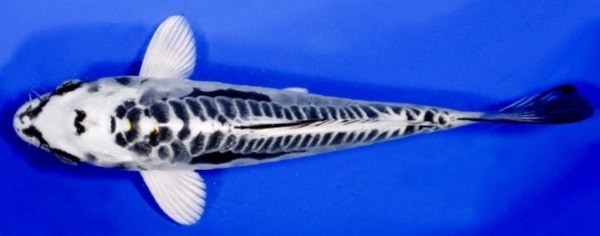
A Kikokuryu (pronounced Key-Ko-Koo-Roo)is always a metallic and always a doitsu (scaless or partially scaled) variety of Koi or Butterfly Koi
Kin Kikokuryu
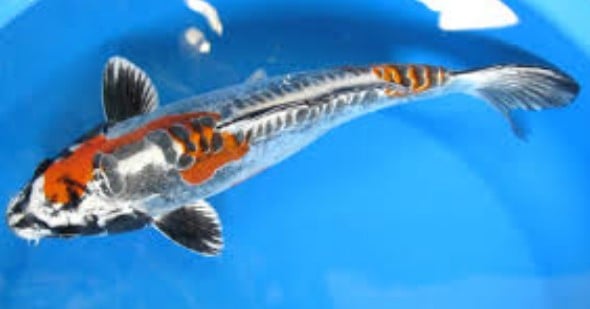
Kin Kikokuryu was first created in 1998 by crossing Kin Showa with Kumonryu by Mr Seiki Igarashi. This metallic koi have changing patterns and can change
Over the years the Kikokuryu has been developed into some other breeds like Beni Kikokuryu, Kin Kikokuryu, and the Pastel Kin Kiko developed By Hanover Koi
Kin Kikokuryu combine orange or yellow with the black and white patterns of Kikokuryu to form the newest variety of koi in the industry
Hikari-Utsurimono
Definition-It is a hybrid of koi of the Utsuri family and the Ogon
Kind
Kin-Showa, Gin-Showa
They are bred by mating the Showa-Sanshoku with the Ogon. Those which have strong golden luster are “Kin-Showa” and those which have platinum luster are “Gin-Showa”
Ginshiro
(Kinshiro-Utsuri) It is the Hikarimono of the Shiro-Utusri with much platinum luster.
Kin-Ki-Utusri It is the HIkarimono of the Shiro-Utsuri with much platinum luster.
Kin-Ki-Utsuri It is a hybrid of the Ki-Utsuri or the Hi-Utusuri
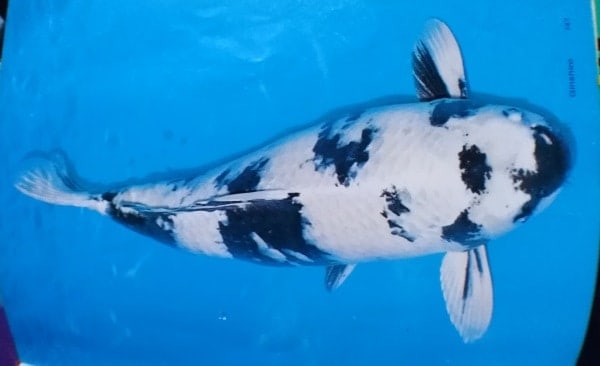
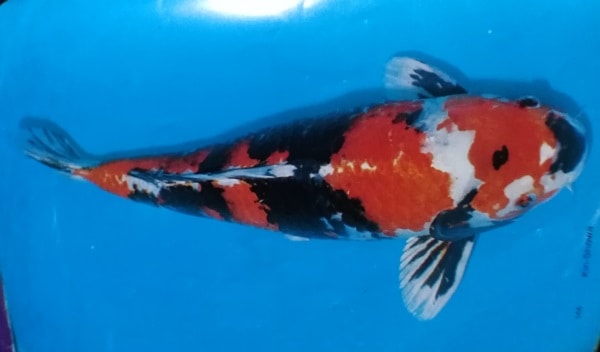
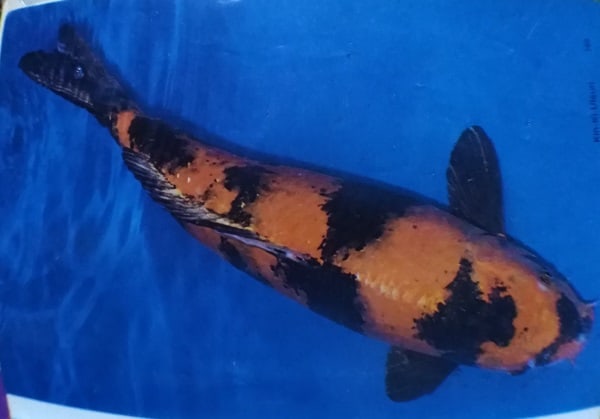
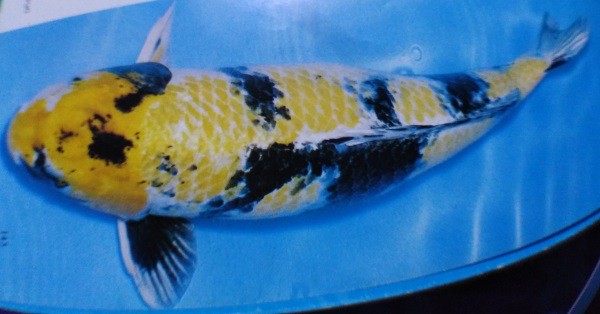
Don’t have space for koi pond? just buy our koi fish paintings
Types of koi people also ask
What is the prettiest koi fish?
Koromo or Goromo is one of the most stunning types of koi fish. It is a hybrid of a Kohaku and an Asagi ki fish. It has the characteristic colors of a Kohaku (white and red) and the characteristic net pattern of the Asagi koi fish
Is there koi fish that stay small?
Do you actually think that all the small fish in the All Japan Show are tosai/small Nisai? They are not. It is true, not all koi will grow large, some/many that are exported are not going to get to jumbo proportions. They actually will stay smaller, usually less than 20-24″, especially the males.
Are butterfly koi real koi?
The butterfly koi is a true koi. Despite this fact, the Japanese have shared some American purist’s distaste for these long fin beauties.
What is a blue koi called?
Shusui are non-metallic blue colored koi with hi accents much like Asagi. Shusui were developed in the early 1900’s by breeding Asagi with Doitsugoi, German scaled carp
how many types of koi fish are there
100 different types
Types of Koi Varieties. There are over a 100 different types of koi (Nishikigoi). To find the proper koi classification you will need to look at their colors, patterns, and body confirmation.
how to distinguish types of koi
Trying to keep all of the varieties and variations of koi straight can be enough to make your head spin. Use this Koi Variety Guide to identify your favorite varieties
how can i tell what types of koi i have
There are over a 100 different types of koi (Nishikigoi). To find the proper koi classification you will need to look at their colors, patterns, and body confirmation.
what are the different types of koi fish
Kohaku. Kohaku are a shiro (white bodied) koi with patches of hi (red markings). …
Sanke.
Taisho Sanshoku, also formally named Taisho Sanke and commonly called Sanke, are a shiro (white) koi with hi (red) which is overlaid with sumi (black) patterns. …
Showa. …
Utsuri. …
Bekko. …
Asagi and Shusui. …
Koromo and Goshiki. …
Kawarimono
how many types of koi fish are there
How many type of koi fish are there?
100 different types
Types of Koi Varieties. There are over a 100 different types of koi (Nishikigoi). To find the proper koi classification you will need to look at their colors, patterns, and body confirmation.
how to distinguish types of koi
Each type of koi fish variety has it’s own specific details for identification and can be described based off another classification of Japanese Koi type. For example, a Showa Sanke is a koi with calligraphic Sumi pattern on Kohaku and the Goshiki was created by breeding Asagi
how many types of koi are there
100 different types
Types of Koi Varieties. There are over a 100 different types of koi (Nishikigoi). To find the proper koi classification you will need to look at their colors, patterns, and body confirmation.
what are the diffrent fin types of koi fish
Koi varieties are distinguished by coloration, patterning, and scalation. Some of the major colors are white, black, red, orange, yellow, blue, and cream.
The most popular category of koi is the Gosanke, which is made up of the Kohaku, Taisho Sanshoku, and Showa Sanshoku varieties.
how many different types of koi fish are there
There are currently over one hundred varieties of koi, with new types … Sanke don’t have sumi markings on their head and very rarely below the lateral line. … these fish grow rapidly and are less skittish that other types of koi.
types of edible fish in koi 2 guide
What food is best for koi fish?
Recommended Koi Food For Champions
Kodama Koi Food – All Season (Wheat Germ) Kodama Koi Food – All Season/Wheat Germ is best for maximum koi growth and health, and its digestibility will allow you to feed your koi all year round. …
Manda Fu Koi Food. …
Color Up Koi Food. …
Hi Silk 21 Sweet Potato
types of edible fish in zen koi 2 guide
Our Zen Koi 2 guide will answer all your questions. … You can control your fish, breed to collect more rare and uncommon fish and finally … There are several new types of prey, power-ups and an enchanting “dragon realm”
most expensive types of koi
Koi Carp: The Most Expensive Koi Fish Ever Sold. Koi fish, humble common carp bred for color and beauty, find their way into art and into the ponds of the very wealthy; the most beautiful have sold for up to $2.2 million.
what are the different types of koi fish
How many types of koi fish are there?
There are over a 100 different types of koi (Nishikigoi). To find the proper koi classification you will need to look at their colors, patterns, and body confirmation
how to distinguish types of koi
However, the main difference that sets the two types of koi fish apart is the Karasu (black-colored body) of the Showa.
Showa has white and red-colored markings over a mostly black-colored body or base. Unlike Sanke, Showa koi fish have a black pattern that runs throughout their bodies
how many different types of koi fish are there
100 different types
There are over a 100 different types of koi (Nishikigoi).
How do I identify a koi fish?
Asagi are koi that display a blue net-like pattern on the back, complemented by red or orange on the belly, gill plates, fins and body. The red or orange pattern will develop up from the bottom of the body as the koi ages. Top quality Asagi have a red pattern that does not extend above the lateral line
how can i tell what types of koi i have
How do I know what type of koi I have?Asagi are koi that display a blue net-like pattern on the back, complemented by red or orange on the belly, gill plates, fins and body.
The red or orange pattern will develop up from the bottom of the body as the koi ages. Top quality Asagi have a red pattern that does not extend above the lateral line
how many types of koi
how many different types of koi are there
what types of koi are there
how many types of koi carp are there,
how to tell different types of koi,
how to identify different types of koi
types of koi fish and meanings
types of koi aWhat are the different types of koi fish?
There are over a 100 different types of koi (Nishikigoi). To find the proper koi classification you will need to look at their colors, patterns, and body confirmation.
…
Most Popular Types of Koi for Shows
Kohaku.
Taisho Sanke.
Showa.
Utsuri mono.
Bekko.
Asagi.
Shusui.
Koromond prices
types of butterfly koi
There are three types of Bekko butterfly koi for sale at Ozark Fisheries. Most often confused with Utsuri, Bekkos are a red (Aka), white (Shiro) or yellow (Ki) butterfly koi with black markings. learn more about different types of butterfly koi here
types of koi and prices
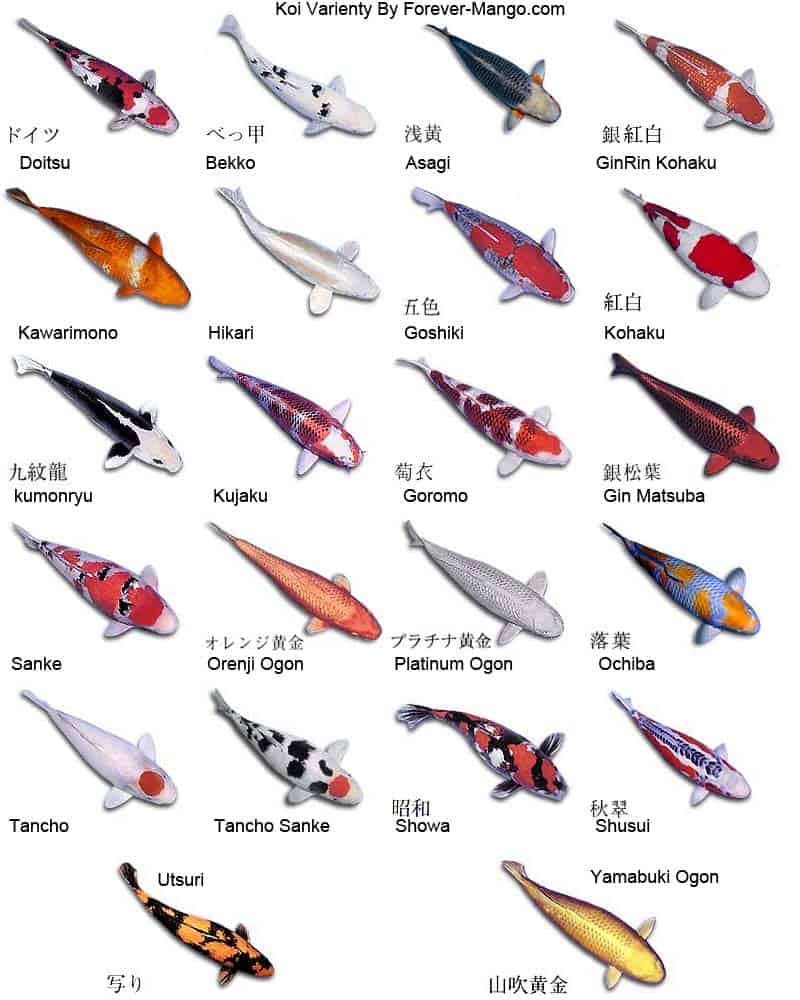
how to identify different types of koi Types of Koi Varieties. There are over a 100 different types of koi (Nishikigoi). To find the proper koi classification you will need to look at their colors, patterns, and body confirmation.
-
colors
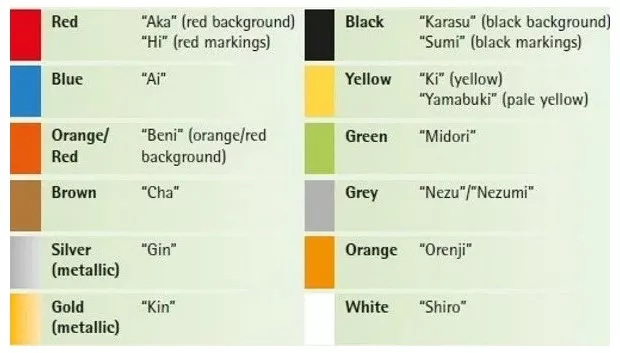
You can easily identify koi fish variety by looking on this koi fish meaning color chart Look at the different types of koi fish below look at their respective variety and refer it to the chart above then you can now easily Identify them if you can memorize the koi fish meaning into English from Japanese terms.
Red Aka when the background is red while Hi if it is red markings, Blue is Ai, Orange/ Red is Beni if orange/red background, Brown Cha, Silver metallic Gin, Gold metallic kin, Black Karasu black background, Sumi black markings, Yellow Ki yellow, Yamabuki pale yellow, Green Midori, Grey Nezu/ Nezumi, Orange Orenji, White Shiro
Matsuba meaning pine cone gives these koi a pattern like no other. They come in 3 colors, the Aka Matsuba being red, the Kin Matsuba being golden, and the Gin Matsuba being white. The Aka Matsuba being the oldest of this variety grows to be guite large
-
patterns
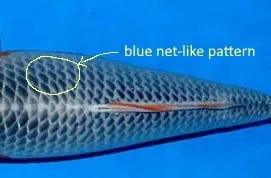
look on the patterns for examaple Asagi. Asagi are koi that display a blue net-like pattern on the back, complemented by red or orange on the belly,
-
body confirmation identify koi fish by body shape
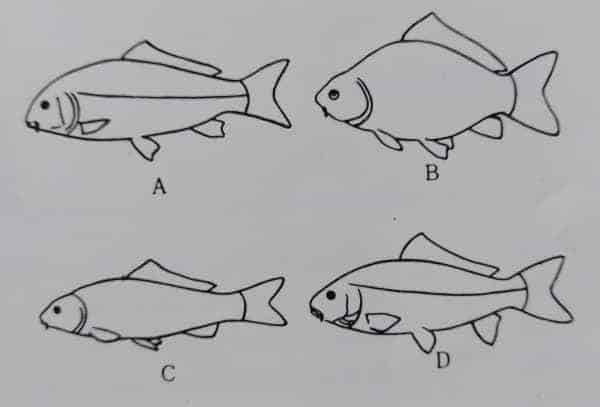
identify koi fish by body shape Koi should be shaped like laser guided bombs – not fat and not thin, with a rounded nose and slim elliptical body which flows from head to tail in one graceful line. Avoid any which are rugby ball shape and any that are very thin so that the head appears overlarge and the body carrot shaped
A. Shinshu Breed B. Ishugrudel Breed C. Natural uncultivated breed D. Japanese Breed
Learn morea bout 15 Fun Koi Fish Facts
koi scale types
What is a scaleless koi called?
Any Doitsu is a scaleless version of a scaled Koi. So it is critical to appreciate the original scaled variety.
types of koi fish and meanings
What do the colors of a koi fish mean?
The red koi often has the connotation of love. … A red or orange koi is a symbol for the mother of the family, and a red or pink koi is a symbol for a daughter. Red koi can also symbolize power and bravery, both common associations with the color red.
They are very much like sanke except they have black on their heads,other popular varieties include the Ogon, Utsuri, Bekko, Asagi, and Doitsu. In the Philippines, a koi with more than two colors is commonly called “multicolor.” They are popular for beginners due to their assortment of colors.
24 types of koi
ki utsuri koi
tancho koi
koi types chart
butterfly koi types
